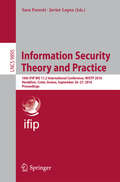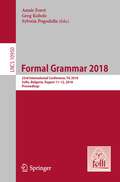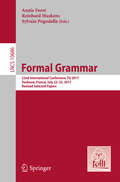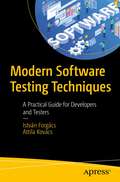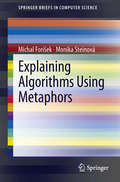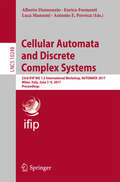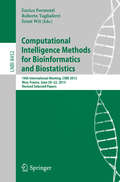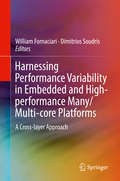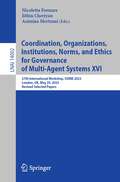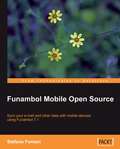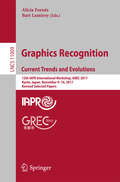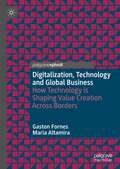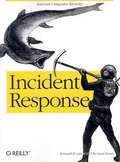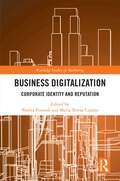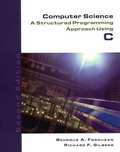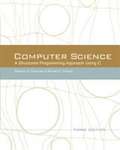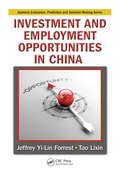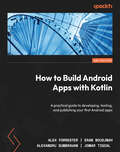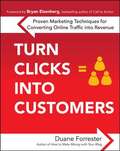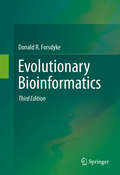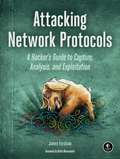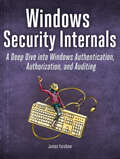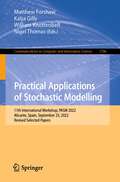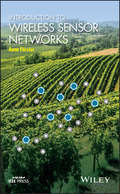- Table View
- List View
Information Security Theory and Practice
by Sara Foresti Javier LopezThis volume constitutes the refereed proceedings of the 10th IFIP WG 11. 2 International Conference on Information Security Theory and Practices, WISTP 2016, held in Heraklion, Crete, Greece, in September 2016. The 13 revised full papers and 5 short papers presented together in this book were carefully reviewed and selected from 29 submissions. WISTP 2016 sought original submissions from academia and industry presenting novel research on all theoretical and practical aspects of security and privacy, as well as experimental studies of fielded systems, the application of security technology, the implementation of systems, and lessons learned. The papers are organized in topical sections on authentication and key management; secure hardware systems; attacks to software and network systems; and access control and data protection.
Formal Grammar 2018: 23rd International Conference, FG 2018, Sofia, Bulgaria, August 11-12, 2018, Proceedings (Lecture Notes in Computer Science #10950)
by Annie Foret Greg Kobele Sylvain PogodallaEdited in collaboration with FoLLI, the Association of Logic, Language and Information, this book constitutes the refereed proceedings of the 23rd International Conference on Formal Grammar, FG 2018, collocated with the European Summer School in Logic, Language and Information in August 2018. The 7 full papers were carefully reviewed and selected from 11 submissions.The focus of papers are as follows: Formal and computational phonology, morphology, syntax, semantics, andpragmatics Model-theoretic and proof-theoretic methods in linguistics Logical aspects of linguistic structure Constraint-based and resource-sensitive approaches to grammar Learnability of formal grammar Integration of stochastic and symbolic models of grammar Foundational, methodological, and architectural issues in grammar and linguistics Mathematical foundations of statistical approaches to linguistic analysis
Formal Grammar: 22nd International Conference, FG 2017, Toulouse, France, July 22-23, 2017, Revised Selected Papers (Lecture Notes in Computer Science #10686)
by Annie Foret Reinhard Muskens Sylvain PogodallaEdited in collaboration with FoLLI, the Association of Logic, Language and Information, this book constitutes the refereed proceedings of the 22nd International Conference on Formal Grammar, FG 2017, collocated with the European Summer School in Logic, Language and Information in July 2017. The 9 contributed papers were carefully reviewed and selected from 14 submissions.The focus of papers are as follows: Formal and computational phonology, morphology, syntax, semantics and pragmatics Model-theoretic and proof-theoretic methods in linguistics Logical aspects of linguistic structure Constraint-based and resource-sensitive approaches to grammar Learnability of formal grammar Integration of stochastic and symbolic models of grammar Foundational, methodological and architectural issues in grammar and linguistics Mathematical foundations of statistical approaches to linguistic analysis
Modern Software Testing Techniques: A Practical Guide for Developers and Testers
by István Forgács Attila KovácsMany books have been written about software testing, but most of them discuss the general framework of testing from a traditional perspective. Unfortunately, traditional test design techniques are often ineffective and unreliable for revealing the various kinds of faults that may occur. This book introduces three new software testing techniques: Two-Phase Model-Based Testing, the Action-State Testing, and the General Predicate Testing, all of which work best when applied with efficient fault revealing capabilities. You’ll start with a short recap of software testing, focusing on why risk analysis is obligatory, how to classify bugs practically, and how fault-based testing can be used for improving test design. You’ll then see how action-state testing merges the benefits of state transition testing and use case testing into a unified approach. Moving on you’ll look at general predicate testing and how it serves as an extension of boundary value analysis, encompassing more complex predicates. Two-phase model-based testing represents an advanced approach where the model does not necessarily need to be machine-readable; human readability suffices. The first phase involves a high-level model from which abstract tests are generated. Upon manual execution of these tests, the test code is generated. Rather than calculating output values, they are merely checked for conformity. The last part of this book contains a chapter on how developers and testers can help each other and work as a collaborative team. What You'll LearnApply efficient test design techniques for detecting domain faultsWork with modeling techniques that combine all the advantages of state transition testing and uses case testingGrasp the two-phase model-based testing technique Use test design efficiently to find almost all the bugs in an applicationWho This Book Is ForSoftware developers, QA engineers, and, business analysts
Explaining Algorithms Using Metaphors
by Michal Forišek Monika SteinováThere is a significant difference between designing a new algorithm, proving its correctness, and teaching it to an audience. When teaching algorithms, the teacher's main goal should be to convey the underlying ideas and to help the students form correct mental models related to the algorithm. This process can often be facilitated by using suitable metaphors. This work provides a set of novel metaphors identified and developed as suitable tools for teaching many of the "classic textbook" algorithms taught in undergraduate courses worldwide. Each chapter provides exercises and didactic notes for teachers based on the authors' experiences when using the metaphor in a classroom setting.
Cellular Automata and Discrete Complex Systems: 23rd IFIP WG 1.5 International Workshop, AUTOMATA 2017, Milan, Italy, June 7-9, 2017, Proceedings (Lecture Notes in Computer Science #10248)
by Enrico Formenti Alberto Dennunzio Luca Manzoni Antonio E. PorrecaThis volume constitutes the thoroughly refereed proceedings of the 23rd IFIP WG 1. 5 International Workshop on Cellular Automata and Discrete Complex Systems, AUTOMATA 2017, held in Milan, Italy, in June 2017. The 14 full papers presented together with one full-length invited paper and 2 invited talk abstracts were carefully reviewed and selected from a total of 28 submissions. The papers feature research on correlated models of automata. The topics include aspects and features of such models: dynamics; topological, ergodic, and algebraic aspects; algorithmic and complexity issues; emergent properties; formal languages; symbolic dynamics; tilings; models of parallelism and distributed systems; timing schemes; synchronous versus asynchronous models; phenomenological descriptions; scientific modelling; practical applications.
Computational Intelligence Methods for Bioinformatics and Biostatistics: 10th International Meeting, CIBB 2013, Nice, France, June 20-22, 2013, Revised Selected Papers (Lecture Notes in Computer Science #8452)
by Enrico Formenti Roberto Tagliaferri Ernst WitThis book constitutes the thoroughly refereed post-conference proceedings of the 10th International Meeting on Computational Intelligence Methods for Bioinformatics and Biostatistics, CIBB 2013, held in Nice, France in June 2013. The 19 revised full papers presented were carefully reviewed and selected from 35 submissions. The papers are organized in topical sections on bioinformatics, biostatistics, knowledge based medicine, and data integration and analysis in omic-science.
Harnessing Performance Variability in Embedded and High-performance Many/Multi-core Platforms: A Cross-layer Approach
by William Fornaciari Dimitrios SoudrisThis book describes the state-of-the art of industrial and academic research in the architectural design of heterogeneous, multi/many-core processors. The authors describe methods and tools to enable next-generation embedded and high-performance heterogeneous processors to confront cost-effectively the inevitable variations by providing Dependable-Performance: correct functionality and timing guarantees throughout the expected lifetime of a platform under thermal, power, and energy constraints. Various aspects of the reliability problem are discussed, at both the circuit and architecture level, the intelligent selection of knobs and monitors in multicore platforms, and systematic design methodologies. The authors demonstrate how new techniques have been applied in real case studies from different applications domain and report on results and conclusions of those experiments. Enables readers to develop performance-dependable heterogeneous multi/many-core architectures Describes system software designs that support high performance dependability requirements Discusses and analyzes low level methodologies to tradeoff conflicting metrics, i.e. power, performance, reliability and thermal management Includes new application design guidelines to improve performance dependability
Coordination, Organizations, Institutions, Norms, and Ethics for Governance of Multi-Agent Systems XVI: 27th International Workshop, COINE 2023, London, UK, May 29, 2023, Revised Selected Papers (Lecture Notes in Computer Science #14002)
by Nicoletta Fornara Jithin Cheriyan Asimina MertzaniThis book constitutes the refereed proceedings of the 27th International Workshop on Coordination, Organizations, Institutions, Norms, and Ethics for Governance of Multi-Agent Systems, COINE 2023, held in London, UK, on May 29, 2023 (co-located with 22nd International Conference on Autonomous Agents and Multi-Agent Systems (AAMAS)).This book contains 10 full papers which are the extended and revised versions of the papers accepted to the workshop.The papers were carefully reviewed and selected from 13 submissions. They are organized in topical sections as follows: Norms, Social contracts, Institutions, and Privacy; Studies on the notion of Value; and Argumentation and Conventions
Funambol Mobile Open Source
by Stefano FornariThe book is composed of two parts. The first part will take you through the steps required to fully understand and deploy Funambol to provide PIM synchronization and push email solution to your mobile users. This is done step-by-step, starting from a simple personal usage scenario to a more complex environment that must serve thousands of users. All components of the platform are smoothly introduced and explained, starting from the functionality they provide. The second part of the book is more informative and will assist you in building Funambol extensions. In particular, it contains an easy-to-follow tutorial that will allow you to write a Funambol connector in a few easy steps. If you are looking forward to install and get started with Funambol, this book is for you. You need to have a technical background and be confident with a bit of code tweaking, but not a developer. General server administration skills are assumed and familiarity with Java will be a benefit in places.
Graphics Recognition. Current Trends and Evolutions: 12th IAPR International Workshop, GREC 2017, Kyoto, Japan, November 9-10, 2017, Revised Selected Papers (Lecture Notes in Computer Science #11009)
by Alicia Fornés Bart LamiroyThis book constitutes the thoroughly refereed post-conference proceedings of the 12th International Workshop on Graphics Recognition, GREC 2017, held in Kyoto, Japan, in November 2017. The 10 revised full papers presented were carefully reviewed and selected from 14 initial submissions. They contain both classical and emerging topics of graphics rcognition, namely analysis and detection of diagrams, search and classification, optical music recognition, interpretation of engineering drawings and maps.
Digitalization, Technology and Global Business: How Technology is Shaping Value Creation Across Borders
by Gaston Fornes Maria AltamiraThis book explores the impact that changes brought by digitalization are having in the way global businesses are run and grown. The main changes in recent years have come from the ubiquitous presence of technology in our daily life (and therefore in business) and also by the direction globalization is taken. Consequently, companies need to review their sources of growth.This book has four primary missions. The first is to critically analyze the impact of digitalization and technology on incumbent international business theories. The second is to deeply understand how digitalization and technology can continue to create growth opportunities. The third is to engage with the opportunities and challenges that digital models and new technologies, digital platforms and Artificial Intelligence in particular, are bringing to the current business and economic environment. And finally, the fourth is to think on possible scenarios and trends that can be the source of growth in the future. This book will be of interest to academics of digital business, international business and innovation and society. It will also be of interest to practitioners and policymakers.
Incident Response
by Richard Forno Kenneth R. van WykAre you ready for a computer "incident," such as a security breach? Incident Responseshows you both the technical and administrative aspects of building an effective incident response plan. You'll learn about the different types of incidents and ways to respond to them, how to put together an incident response team, what procedures to use, what tools there are for investigating incidents, and where to find extensive online resources.
Business Digitalization: Corporate Identity and Reputation (Routledge Studies in Marketing)
by Pantea Foroudi Maria Teresa CuomoTechnological advances, alongside increasing globalization and growing awareness of socio-cultural and socio-political issues, are driving corporate branding innovations, and organizations must react and adapt quickly to compete. This book investigates and explores the impact of digital transformation on building corporate branding, identity and reputation. This book brings together international contributors to provide examples from a wide range of industries and firms, including the retailing and agrifood industries, and illustrates the many dimensions of corporate branding and theories and how they can be aided by digital transformation. It explores the connection of branding with artificial intelligence, social media networks and technologies 4.0, as well as the limitations and challenges they might deliver. Using a combination of theory, primary research findings and practice, this book offers viewpoints and expertise from multiple regions, appealing to a global audience. This edited collection serves as an important resource for researchers, scholars and postgraduate students of marketing, brand management and corporate communications and those interested in the emerging relationship with technology.
Computer Science: A Structured Programming Approach Using C (2nd edition)
by Behrouz A. Forouzan Richard F. GilbergThis textbook introduces the basic principles of programming as outlined in the ACM curriculum for a CS1 class, and the basic concepts of the C language. The second edition adds new exercises, projects and problems to the end of chapter material.
Computer Science: A Structured Programming Approach Using C (3rd edition)
by Behrouz A. Forouzan Richard F. GilbergThe third edition of Computer Science: A Structured Programming Approach Using C continues to present both computer science theory and C-language syntax with a principle-before-implementation approach. Forouzan and Gilberg employ a clear organizational structure, supplemented by easy-to-follow figures, charts, and tables. The new edition has been thoroughly updated to reflect the new C99 standard, and includes a revised chapter sequence to better aid student learning.
Investment and Employment Opportunities in China (Systems Evaluation, Prediction, and Decision-Making #9)
by Jeffrey Yi-Lin Forrest Tao LixinPresenting the most recent statistical data, Investment and Employment Opportunities in China provides first-of-its-kind coverage of the regional economic, industrial, investment, and employment structures in China. After establishing the theoretical foundation, the rest of the book utilizes the model and the methodology presented by the authors to
How to Build Android Apps with Kotlin: A practical guide to developing, testing, and publishing your first Android apps, 2nd Edition
by Alex Forrester Eran Boudjnah Alexandru Dumbravan Jomar TigcalUnleash the power of Android programming to build scalable and reliable apps using industry best practicesPurchase of the print or Kindle book includes a free PDF eBookKey FeaturesBuild apps with Kotlin, Google's preferred programming language for Android developmentUnlock solutions to development challenges with guidance from experienced Android professionalsImprove your apps by adding valuable features that make use of advanced functionalityBook DescriptionLooking to kick-start your app development journey with Android 13, but don't know where to start? How to Build Android Apps with Kotlin is a comprehensive guide that will help jump-start your Android development practice. This book starts with the fundamentals of app development, enabling you to utilize Android Studio and Kotlin to get started with building Android projects. You'll learn how to create apps and run them on virtual devices through guided exercises. Progressing through the chapters, you'll delve into Android's RecyclerView to make the most of lists, images, and maps, and see how to fetch data from a web service. You'll also get to grips with testing, learning how to keep your architecture clean, understanding how to persist data, and gaining basic knowledge of the dependency injection pattern. Finally, you'll see how to publish your apps on the Google Play store. You'll work on realistic projects that are split up into bitesize exercises and activities, allowing you to challenge yourself in an enjoyable and attainable way. You'll build apps to create quizzes, read news articles, check weather reports, store recipes, retrieve movie information, and remind you where you parked your car. By the end of this book, you'll have the skills and confidence to build your own creative Android applications using Kotlin.What you will learnCreate maintainable and scalable apps using KotlinUnderstand the Android app development lifecycleSimplify app development with Google architecture componentsUse standard libraries for dependency injection and data parsingApply the repository pattern to retrieve data from outside sourcesBuild user interfaces using Jetpack ComposeExplore Android asynchronous programming with Coroutines and the Flow APIPublish your app on the Google Play storeWho this book is forIf you want to build Android applications using Kotlin but are unsure of how and where to begin, then this book is for you. To easily grasp the concepts in this book, a basic understanding of Kotlin, or experience in a similar programming language is a must.
How to Build Android Apps with Kotlin: A practical guide to developing, testing, and publishing your first Android apps
by Alex Forrester Eran Boudjnah Alexandru Dumbravan Jomar TigcalUnleash the power of Android programming to build scalable and reliable apps using industry best practices Purchase of the print or Kindle book includes a free PDF eBookKey FeaturesBuild apps with Kotlin, Google’s preferred programming language for Android developmentUnlock solutions to development challenges with guidance from experienced Android professionalsImprove your apps by adding valuable features that make use of advanced functionalityBook DescriptionLooking to kick-start your app development journey with Android 13, but don’t know where to start? How to Build Android Apps with Kotlin is a comprehensive guide that will help jump-start your Android development practice. This book starts with the fundamentals of app development, enabling you to utilize Android Studio and Kotlin to get started with building Android projects. You'll learn how to create apps and run them on virtual devices through guided exercises. Progressing through the chapters, you'll delve into Android's RecyclerView to make the most of lists, images, and maps, and see how to fetch data from a web service. You'll also get to grips with testing, learning how to keep your architecture clean, understanding how to persist data, and gaining basic knowledge of the dependency injection pattern. Finally, you'll see how to publish your apps on the Google Play store. You'll work on realistic projects that are split up into bitesize exercises and activities, allowing you to challenge yourself in an enjoyable and attainable way. You'll build apps to create quizzes, read news articles, check weather reports, store recipes, retrieve movie information, and remind you where you parked your car. By the end of this book, you'll have the skills and confidence to build your own creative Android applications using Kotlin.What you will learnCreate maintainable and scalable apps using KotlinUnderstand the Android app development lifecycleSimplify app development with Google architecture componentsUse standard libraries for dependency injection and data parsingApply the repository pattern to retrieve data from outside sourcesBuild user interfaces using Jetpack ComposeExplore Android asynchronous programming with Coroutines and the Flow APIPublish your app on the Google Play storeWho this book is forIf you want to build Android applications using Kotlin but are unsure of how and where to begin, then this book is for you. To easily grasp the concepts in this book, a basic understanding of Kotlin, or experience in a similar programming language is a must.
Turn Clicks Into Customers: Proven Marketing Techniques For Converting Online Traffic Into Revenue
by Duane ForresterTHE MAIN PURPOSE of this book is to help you monetize your Web site. While that might sound exciting, keep in mind that it takes a lot of work to accomplish. Whether you have a small or large Web site is immaterial for this discussion--scale matters less than structure and your willingness to follow specific best practices.
Evolutionary Bioinformatics
by Donald R. ForsdykeNow in its third edition and supplemented with more online material, this book aims to make the "new" information-based (rather than gene-based) bioinformatics intelligible both to the "bio" people and the "info" people. Books on bioinformatics have traditionally served gene-hunters, and biologists who wish to construct family trees showing tidy lines of descent. While dealing extensively with the exciting topics of gene discovery and database-searching, such books have hardly considered genomes as information channels through which multiple forms and levels of information have passed through the generations. This "new bioinformatics" contrasts with the "old" gene-based bioinformatics that so preoccupies previous texts. Forms of information that we are familiar with (mental, textual) are related to forms with which we are less familiar (hereditary). The book extends a line of evolutionary thought that leads from the nineteenth century (Darwin, Butler, Romanes, Bateson), through the twentieth (Goldschmidt, White), and into the twenty first (the final works of the late Stephen Jay Gould). Long an area of controversy, diverging views may now be reconciled.
Attacking Network Protocols: A Hacker's Guide to Capture, Analysis, and Exploitation
by James ForshawAttacking Network Protocols is a deep dive into network protocol security from James Forshaw, one of the world’s leading bug hunters. This comprehensive guide looks at networking from an attacker’s perspective to help you discover, exploit, and ultimately protect vulnerabilities.You’ll start with a rundown of networking basics and protocol traffic capture before moving on to static and dynamic protocol analysis, common protocol structures, cryptography, and protocol security. Then you’ll turn your focus to finding and exploiting vulnerabilities, with an overview of common bug classes, fuzzing, debugging, and exhaustion attacks. Learn how to:- Capture, manipulate, and replay packets- Develop tools to dissect traffic and reverse engineer code to understand the inner workings of a network protocol- Discover and exploit vulnerabilities such as memory corruptions, authentication bypasses, and denials of service- Use capture and analysis tools like Wireshark and develop your own custom network proxies to manipulate network trafficAttacking Network Protocols is a must-have for any penetration tester, bug hunter, or developer looking to understand and discover network vulnerabilities.
Windows Security Internals: A Deep Dive into Windows Authentication, Authorization, and Auditing
by James ForshawPower up your Windows security skills with expert guidance, in-depth technical insights, and dozens of real-world vulnerability examples from Google Project Zero&’s most renowned researcher! Learn core components of the system in greater depth than ever before, and gain hands-on experience probing advanced Microsoft security systems with the added benefit of PowerShell scripts.Windows Security Internals is a must-have for anyone needing to understand the Windows operating system&’s low-level implementations, whether to discover new vulnerabilities or protect against known ones. Developers, devops, and security researchers will all find unparalleled insight into the operating system&’s key elements and weaknesses, surpassing even Microsoft&’s official documentation.Author James Forshaw teaches through meticulously crafted PowerShell examples that can be experimented with and modified, covering everything from basic resource security analysis to advanced techniques like using network authentication. The examples will help you actively test and manipulate system behaviors, learn how Windows secures files and the registry, re-create from scratch how the system grants access to a resource, learn how Windows implements authentication both locally and over a network, and much more.You&’ll also explore a wide range of topics, such as:Windows security architecture, including both the kernel and user-mode applicationsThe Windows Security Reference Monitor (SRM), including access tokens, querying and setting a resource&’s security descriptor, and access checking and auditingInteractive Windows authentication and credential storage in the Security Account Manager (SAM) and Active DirectoryMechanisms of network authentication protocols, including NTLM and KerberosIn an era of sophisticated cyberattacks on Windows networks, mastering the operating system&’s complex security mechanisms is more crucial than ever. Whether you&’re defending against the latest cyber threats or delving into the intricacies of Windows security architecture, you&’ll find Windows Security Internals indispensable in your efforts to navigate the complexities of today&’s cybersecurity landscape.
Practical Applications of Stochastic Modelling: 11th International Workshop, PASM 2022, Alicante, Spain, September 23, 2022, Revised Selected Papers (Communications in Computer and Information Science #1786)
by Matthew Forshaw Katja Gilly William Knottenbelt Nigel ThomasThis book constitutes the referred proceedings of the 11th International Workshop on Practical Applications of Stochastic Modelling, PASM 2022, was held in Alicante, Spain, in September 2022.The 7 full papers presented in this volume were carefully reviewed and selected from 9 submissions. The papers demonstrate a diverse set of applications and approaches of stochastic modelling.
Introduction to Wireless Sensor Networks
by Anna FörsterExplores real-world wireless sensor network development, deployment, and applications Presents state-of-the-art protocols and algorithms Includes end-of-chapter summaries, exercises, and references For students, there are hardware overviews, reading links, programming examples, and tests available at [website] For Instructors, there are PowerPoint slides and solutions available at [website]
